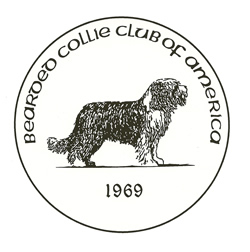“Oh, I didn’t know that!” A friend and I were discussing Beardies (what else) and I mentioned my old girl, Glynnis, was looking rather strange with her two-toned coat. Sometime during the summer a determined flea had found her and before I could get to the vet for the anti-flea armament, she had chewed her rump till it was raw and bleeding. Once the flea had been dispersed to wherever dead fleas go (and I’m sure it’s not heaven), her coat began to grow back jet black where the skin had been masticated. It was quite a contrast with the rest of her slate coat. “But, it was to be expected,” I related, “since Beardie coats reappear in the color they were at birth in a case like this.” That’s when my friend, who has had Beardies for some 15 years admitted she didn’t know about that attribute.
If the injury is small or if the adult coat has stayed close to the birth color, the splotch of new growth could go unnoticed. For instance, some Beardies are born black and stay that way so the new growth wouldn’t be apparent. Usually the hair on the injured spot will gradually blend in with the rest of the coat. In Glynnis’ case, it’s a fairly large area over her rump and extending partway down her tail, so it’s highly conspicuous.
When it comes to a subject for conversation, the Beardie coat is unbeatable. The incredible color changes which transpire in sundry coats has led owners to recite, ‘If you don’t like the color of your Beardie’s coat, just wait a minute.’ On one occasion, our group put on a seminar for would-be Beardie judges and featured a series of color slides of a brown dog from puppyhood to four years of age, at which time we brought him out for viewing in person (in canis?) That’s when one of the judges stood up and incredulously asked, “Do you mean that was all the same dog?” Assured that he was one and the same, some of the judges group asked, ‘May we see the slides one more time?’ Another of the judges commented it must be frustrating for owners to advertise because “the dogs could be a different color by the time the picture appears in print.”
It’s true some Beardies undergo drastic changes such as light browns or fawns fading to almost cream or white while retaining just a bit of color on the ears as they convert from puppy coat to adult. One of the most radical changes in my experience happened to my now four-year-old Keira who was black at birth, changing to white with gray only on the head and shoulders as a youngster. To my relief, she then became a respectable charcoal as an adult.
Brit, one of my early Beardies, was a brown whose adult coat changed shades about twice a year, resulting in distinctive bands of dark mahogany through russet, sienna, gold, chestnut, champagne and bronze. When he passed away, I kept a lock of his coat but it wasn’t the same as when it rippled in the wind or swirled around his legs as he glided across the fields or in the ring.
Looking at a Beardie, bystanders will often ask, “What do you call that color?” and then look surprised when the owner replies “brown” (or black or fawn or blue). It’s impossible to put a name to a color which may change to another shade in a short space of time. While other breeds’ standards describe coats in such picturesque terms as sedge, deadgrass, russet, liver, slate or wheaten, Beardies are identified simply as ‘born black, born brown, born blue or born fawn.’
What they’ll become after that is anybody’s guess. And that’s just one of the abundant things which makes our breed so interesting.
— alice bixler, Summerfield, Florida, Bearded Collie Club of America




